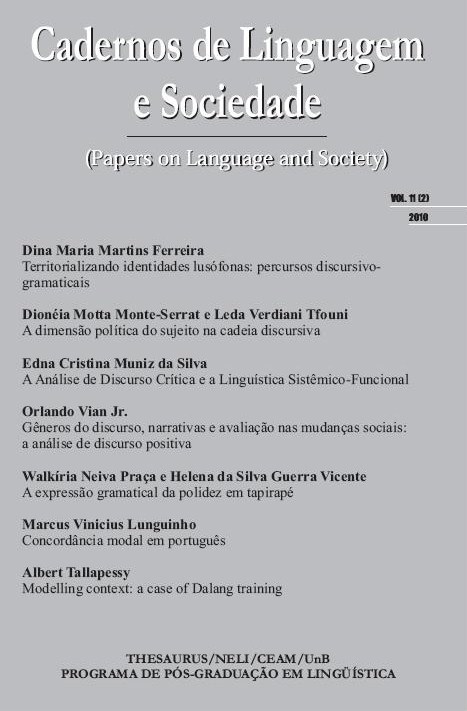On modal concord in Portuguese
DOI:
https://doi.org/10.26512/les.v11i2.10474Keywords:
concordância modal; modalidade; quantificação; verbos auxiliares modais.Abstract
In this paper I discuss modal concord in Portuguese. This phenomenon, initially described by Halliday (1970), is characterized by the syntactic presence of two modal elements which are interpreted as if there was just one of them. Based on Kratzer’s (1981, 1991) theory of Modality, I analyze Portuguese data and point out, in accordance with the literature (Geurts & Huitink 2006, Zeijlstra 2007 e Huitink 2009), that modal concord obeys
two constraints: a) one of the modal elements must be a modal auxiliary verb, and b) the modal elements must share the same modal force and type of modality.
Downloads
References
Baker, C. Learnability and the English auxiliary system. In: Baker, C. & McCarthy, J. (eds.) The Logical Problem of Language Acquisition. Cambridge, MA: MIT Press, 1981, p. 296-323.
von Fintel, K. Modality and Language. In: Borchert, D. (ed.). Encyclopedia of Philosophy. Detroit: MacMillan, 2006, p. 20-27.
von Fintel, K & Iatridou, S. What to do if you want to go to Harlem: Notes on anankastic conditionals and related matters. MIT, 2005. Disponível em: <http://web.mit.edu/fintel/www/harlem.pdf> Acesso em 27/09/2010.
Geurts, B. & Huitink, J. Modal concord. In: Dekker, P & Zeijstra, H. (eds.) Proceedings of the ESSLLI 2006 Workshop Concord Phenomena at the Syntax Semantics Interface. 15-20. University of Malaga, 2006, p. 15-20.
Hacquard, V. (no prelo). Modality. A sair em: Maierborn, C; von Heusinger, K & Portner, P. (eds.) Semantics: An International Handbook of Natural Language Meaning. Berlin: Walter De Gruyter.
Hacquard, V. Aspects of Modality. Tese de Doutorado. Cambridge, MA: Massachusetts Institute of Technology.
Halliday, M. Functional diversity in language as seen from a consideration of modality and mood in English. Foundations of Language, 6: 332-361, 1970.
Hockett, C. The origins of speech. Scientific American, 203: 89-97, 1960.
Hoye, L. Adverbs and Modality in English. London and New York: Longman, 1997.
Huitink, J. Modal concord: a case study of Dutch. Frankfurt: Goethe Universität, 2009. Disponível em: <http://user.uni-frankfurt.de/~huitink/Huitink-modalconcord.pdf> Acesso em 10/06/2010.
Kratzer, A. Modality. In: von Stechow, A. & Wunderlich, D. (eds.). Semantics: an international handbook of contemporary research, Berlin: Mouton de Gruyter, 1991, p. 639”“650.
Kratzer, A. The notional category of modality. In: Eikmeyer, H.-J. & Rieser, H. (eds.) Words, Worlds, and Contexts. New Approaches in Word Semantics. Berlin: Mouton de Gruyter, 1981, p. 38-74.
Kratzer, A. What must and can must and can mean. Linguistics and Philosophy, 1(3): 337”“355, 1977.
Lewis, D. Counterfactuals. Cambridge, MA: Harvard University Press, 1973.
Lightfoot, D. How to Set Parameters: Arguments from language change. Cambridge, MA: MIT Press, 1991.
Lightfoot, D. Principles of Diachronic Syntax. Cambridge: Cambridge University Press, 1979.
Lobato, L. Os verbos auxiliares em português contemporâneo: critérios de auxiliaridade. In: Lobato, L. et alii. Análises Lingüísticas. Petrópolis: Vozes, 1975, p. 27-91.
Lunguinho, M. A Ordem dos Verbos Auxiliares: uma análise em termos de traços. Dissertação de Mestrado. Brasília: Universidade de Brasília, 2005.
Lyons, J. Semantics. Cambridge: Cambridge University Press, 1977.
McCawley, J. Tense and time reference in English. In: Fillmore, C. & Langendoen, T. (eds.) Studies in Linguistics Semantics. New York: Holt, Rinehart & Winston, 1971, p. 96-113.
Miranda, Z. Aspectos do Comportamento Sintático dos Modais dever e poder.Dissertação de Mestrado. Campinas: Universidade Estadual de Campinas, 1975.
Palmer, F. Mood and Modality. Cambridge: Cambridge University Press, 1986.
Pires de Oliveira, R. & Ngoy, F. Notas sobre a semântica do sufixo -vel: a expressão da modalidade no PB. Revista Letras, 73: 185-201, 2007.
Pontes, E. Verbos Auxiliares em Português. Petrópolis: Vozes, 1973.
Pullum, G. & Wilson, D. Autonomous syntax and the analysis of auxiliaries. Language 53(4): 741-788, 1977.
Roberts, I & Roussou, A. Syntactic Change: a minimalist approach to grammaticalization. Cambridge: Cambridge University Press, 2003.
Roberts, I. Agreement parameters and the development of English modal auxiliaries. Natural Language and Linguistic Theory, 3: 21”“58, 1985.
Schachter, P. Explaining auxiliary order. In: Heny, F. & Richards, B. (eds.) Auxiliaries and Related Puzzles. Volume II. Dordrecht: Reidel, 1983, p.145-204.
Stowell, T. Tense and modals. In: Guéron, J. & Lecarme, J (eds.) The Syntax of Time. Cambridge, MA: MIT Press, 2004, p. 621-635.
Tavares de Macedo, A. Dois Modelos de Análise para os Auxiliares em Português. Dissertação de Mestrado. Rio de Janeiro: Universidade Federal do Rio de Janeiro, 1972.
Zeijlstra, H. Modal concord. In Friedman, T. & Gibson, M. Proceedings of SALT XVII. Ithaca, NY: Cornell University, 2007, p. 317-332.



